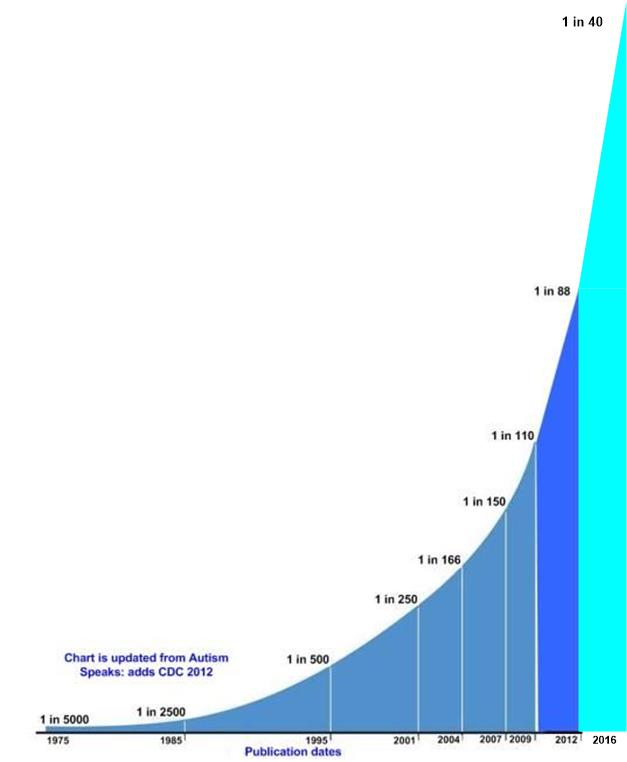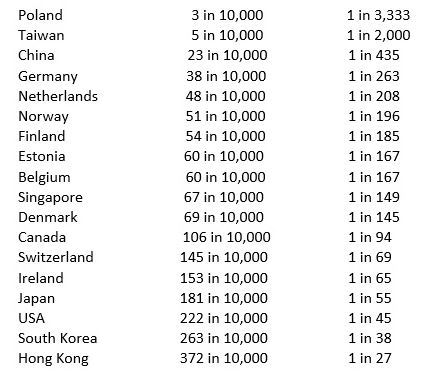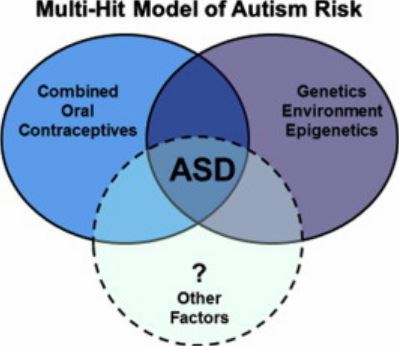Autism – 1 in 40 children in the US (as of 2016)
The Prevalence of Parent-Reported Autism Spectrum Disorder Among US Children Pediatrics
Includes a 4 minute video abstract
 ---
1. A variety of stressors increase the risk of Autism - but only if low Vitamin D?
* Vaccinated children had more chronic diseases - Sept 2018
* Off topic: CDC deleted a 3X increase in black male autism due to vaccination – whistle blowing Aug 2014
* Autism risk increased if infant had antibiotics (2X), acetaminophen (3X), or no vitamin D drops (1.5X) – June 2018
* Hypothesis - Autism can be different between twins due to HPV differences in placenta – Nov 2017
* Autism associated with low gut flora (due to antibiotics ) – Mercola Oct 2014
* Herpes virus infection while pregnant increases Autism risk by 2 X (Vitamin D not mentioned) – Feb 2017
* 20 X more Parkinson's and 100X more Autism with GMO soy in China
* Autism 17 times more likely with excessive Folic Acid and B-12 (now added to bread) – May 2016 - has the following -Autism Rates across the Developed World Aug 2017
*
---
1. A variety of stressors increase the risk of Autism - but only if low Vitamin D?
* Vaccinated children had more chronic diseases - Sept 2018
* Off topic: CDC deleted a 3X increase in black male autism due to vaccination – whistle blowing Aug 2014
* Autism risk increased if infant had antibiotics (2X), acetaminophen (3X), or no vitamin D drops (1.5X) – June 2018
* Hypothesis - Autism can be different between twins due to HPV differences in placenta – Nov 2017
* Autism associated with low gut flora (due to antibiotics ) – Mercola Oct 2014
* Herpes virus infection while pregnant increases Autism risk by 2 X (Vitamin D not mentioned) – Feb 2017
* 20 X more Parkinson's and 100X more Autism with GMO soy in China
* Autism 17 times more likely with excessive Folic Acid and B-12 (now added to bread) – May 2016 - has the following -Autism Rates across the Developed World Aug 2017
*  ---
1. Autism Epidemiology on the web
* Wikipedia
* The Changing Epidemiology of Autism Spectrum Disorders - 2017
* Includes many of the stressors mentioned above
* * *📄 Download the PDF from VitaminDWiki *
* Prevalence and trends in epidemiology of autism Video 2015
Some images
---
1. Autism Epidemiology on the web
* Wikipedia
* The Changing Epidemiology of Autism Spectrum Disorders - 2017
* Includes many of the stressors mentioned above
* * *📄 Download the PDF from VitaminDWiki *
* Prevalence and trends in epidemiology of autism Video 2015
Some images

 The link between oral contraceptive use and prevalence in autism spectrum disorder 2014, free PDF
The link between oral contraceptive use and prevalence in autism spectrum disorder 2014, free PDF
📄 Download the PDF from Sci-Hub via VitaminDWiki
OBJECTIVES: To estimate the national prevalence of parent-reported autism spectrum disorder (ASD) diagnosis among US children aged 3 to 17 years as well as their treatment and health care experiences using the 2016 National Survey of Children’s Health (NSCH).
METHODS: The 2016 NSCH is a nationally representative survey of 50 212 children focused on the health and well-being of children aged 0 to 17 years. The NSCH collected parent-reported information on whether children ever received an ASD diagnosis by a care provider, current ASD status, health care use, access and challenges, and methods of treatment. We calculated weighted prevalence estimates of ASD, compared health care experiences of children with ASD to other children, and examined factors associated with increased likelihood of medication and behavioral treatment.
RESULTS: Parents of an estimated 1.5 million US children aged 3 to 17 years ( 2.50% ) reported that their child had ever received an ASD diagnosis and currently had the condition. Children with parent-reported ASD diagnosis were more likely to have greater health care needs and difficulties accessing health care than children with other emotional or behavioral disorders (attention-deficit/hyperactivity disorder, anxiety, behavioral or conduct problems, depression, developmental delay, Down syndrome, intellectual disability, learning disability, Tourette syndrome) and children without these conditions. Of children with current ASD, 27% were taking medication for ASD-related symptoms, whereas 64% received behavioral treatments in the last 12 months, with variations by sociodemographic characteristics and co-occurring conditions.
CONCLUSIONS: The estimated prevalence of US children with a parent-reported ASD diagnosis is now 1 in 40, with rates of ASD-specific treatment usage varying by children’s sociodemographic and co-occurring conditions.
- “The costs of caring for a child with ASD in the United States, including health care and non–health care services, was estimated at $17 081 per year beyond the costs of caring for a child without ASD…”
